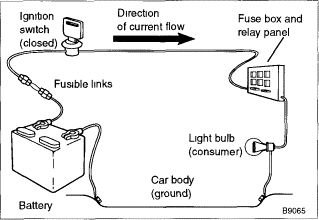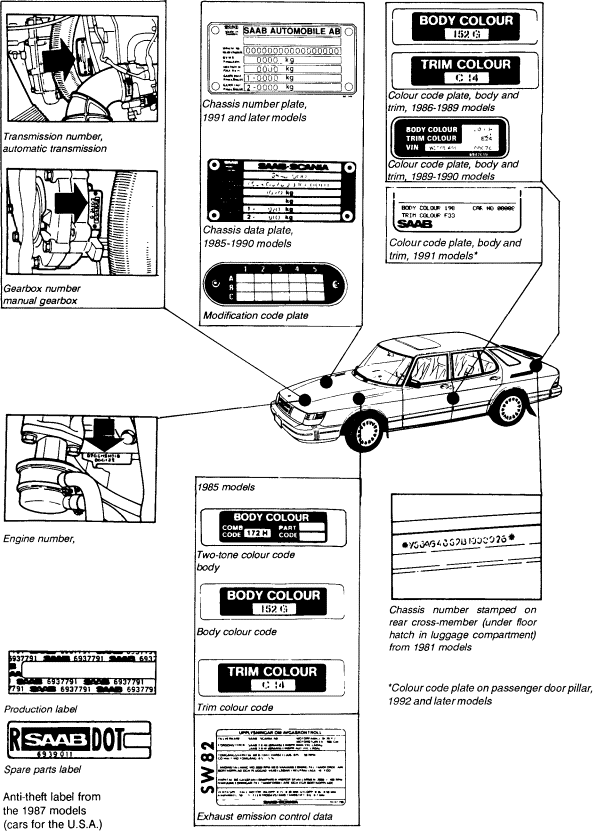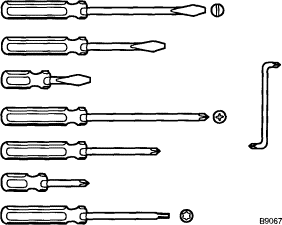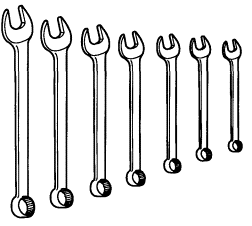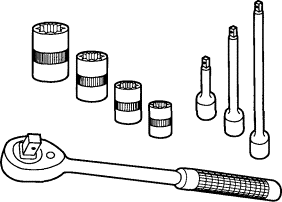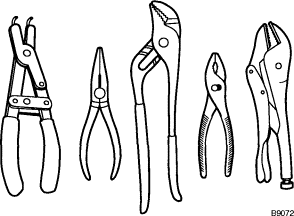 |
|
..:: SAAB FAQ :: 900 Old Generation :: Áåíòëè :: ×àñòü 1 ::..Electrical Testing A great many electrical problems can be understood and solved with only a little fundamental knowledge of how electrical circuits function. Electric current only flows in a complete circuit. To operate, every electrical device in the car requires a complete circuit including a voltage source and a path to ground. The positive (+) side of the battery is the original voltage source, and ground is any return path to the negative (-) side of the battery, whether through the wiring harness or the car body. Except for portions of the charging system, all electrical current in the car is direct current (DC) and flows from positive (+) to negative (-). Switches are used to turn components on or off by completing or interrupting the circuit. A switch is "open" when the circuit is interrupted, and"closed" when the circuit is completed. Fig. 18 shows a complete circuit schematically. See 3 ELECTRICAL SYSTEM for electrical troubleshooting.
Fig. 18. Schematic representation of simple circuit for light bulb. Switch is shown closed, making circuit complete Wire Repairs Repairs to a wiring harness to reconnect broken wires or correct shorts to ground deserve special care to make the repair permanent. The wire ends must be clean. If frayed or otherwise damaged, cut off the end. If the wire is too short, splice in a new piece of wire of the same size and make two connections. Use connectors that are designed for the purpose. Crimped-on or soldered-on connectors are best.Crimp connectors and special crimping pliers are widely available. If soldering, use a needle nose pliers to hold the wire near the solder joint and create a"heat dam". This keeps the heat and the solder from traveling up the wire. Always use a solder made specifically for electrical work. NOTE Twisting wires together is really only a temporary repair, since corrosion and vibration will eventually spoil the connection. Insulate the finished connection. Electronics stores can supply heat-shrunkable insulating tubing that can be placed onto the wire before connecting, slid over the finished joint, and shrunk to a tight fit with a heat gun or hair dryer. The next best alternative is electrical tape. Make sure the wire is clean and free of solder flux or other contamination. Wrap the joint tightly and completely to seal out moisture. BUYING PARTS Many of the maintenance and repair tasks in this manual call for the installation of new parts, or the use of new gaskets and other materials when reinstalling parts. Most often, the parts that will be needed should be on hand before beginning the job. Read the introductory text and the complete procedure to determine which parts will be needed. NOTE For some bigger Jobs, partial disassembly and inspection are required to determine a complete parts list. Read the procedure carefully and, if necessary, make other arrangements to get the necessary parts while your car is disassembled. Information You Need To Know Fig. 19 shows the locations of the important information that may be necessary to have on hand when buying parts or having work done on the car.
Fig. 19.Locations of important information that may be required when buying parts. Genuine SaabParts Genuine Saab replacement parts from an authorized Saab dealer are designed and manufactured to the same high standards as the original parts. They will be the correct material, manufactured to the same specifications, and guaranteed to fit and work as intended by the engineers who designed the car. Some genuine Saab parts have a limited warranty. Many independent repair shops make a point of using genuine Saab parts, even though they may at times be more expensive. They know the value of doing the job right with the right parts. Parts from other sources can be as good, particularly if manufactured by one of Saabs original equipment suppliers, but it is often difficult to know. Saab is constantly updating and improving their cars, often making improvements during a given model year. Saab may recommend a newer, improved part as a replacement, and your authorized dealer's parts department will know about it and provide it. The Saab parts organization is best equipped to deal with any Saab parts needs. Non-returnable Parts Some parts can not be returned for credit, even if they are the wrong parts for the car. The best example is electrical parts, which are almost universally considered non-returnable because they are so easily damaged internally. Buy electrical parts carefully, and be as sure as possible that a replacement is needed, especially for expensive parts such as control units. It may be wise to let an authorized Saab dealer or other qualified shop confirm your diagnosis before replacing an expensive part that can not be returned. TOOLS Most maintenance can be accomplished with a small selection of the right tools. Tools range in quality from inexpensive junk, which may break at first use, to very expensive and well-made tools which, to the professional, are worth every bit of their high cost. The best tools for most do-it-yourself Saab owners lie somewhere in between. Cheap tools are not a bargain. They often do not hold up to even casual use, and they present a greater risk of personal injury. If they fit poorly, they can actually damage the fasteners they are intended to remove, making it that much harder to use a good tool the next time around. Many reputable tool manufacturers offer good quality, moderately priced tools with a lifetime guarantee. A broken tool can be exchanged for a new one, for the life of the tool. These are your best buy. They cost a little more, but they are good quality tools that will do what is expected of them. Sears' Craftsman® line is one such source of good quality, reasonably priced, and guaranteed tools. Other sources of special tools are: Schley Products Inc. 5350 E. Hunter Ave., Anaheim Hills, CA92807 (714)693-7666 Baum Tools Unltd. Inc. P.O. Box 87, Longboat Key, FL 34228 (800)848-6657 Assenmacher Specialty Tools 6440 Odell Place, Boulder, CO 80301 (303) 530-2424 Basic Tool Requirements NOTE Saabs are delivered with a tool kit mounted to the underside of the trunk lid. The kit contains a basic selection of tools that may fulfill some of the requirements listed in this section The basic hand tools described below can be used to accomplish most of the simple maintenance and repair tasks. Screwdrivers. Three types, the common flat-blade type, the Phillips type will handle almost all screws used on Saabs. Two or three different sizes of each type will be best, since a screwdriver of the wrong size will damage the screwhead. On late models Saabs, Torx® screw are quite common. A T25 size Torxdriver will handle most of these screws. A complete set of screwdrivers can often be purchased for about the same money as the four or six individual ones that are really necessary. See Fig. 20.
Fig. 20.Common flat-blade (top), Phillips (middle) and Torx® (bottom) screwdrivers. Offset screwdriver (right) isused for screws with limited access For a more complete tool box, include "stubby" screwdrivers or offset screwdrivers for use in tight spots where a normal length screwdriver will not easily fit and Torx® head screwdrivers. Wrenches. Wrenches come in different styles for different uses. Fig. 21 shows several. The basic open-end wrench is the most widely used, but grips on only two sides. It can spread a part and slip off more easily. The box-end wrench has better grip, on all six sides of a nut or bolt, and is much less prone to slip.
Fig. 21. Types of wrench heads From left, open-end, 12 point box-end 6 point box-end flare nut A12-point box-end can loosen a nut or bolt where there is less room for movement, while a 6-point box-end provides better grip. For hex fasteners on fluid lines, like brake lines and fuel lines, a flare-nut wrench offers the advantages of a box-end wrench with a slot that allows it to fit over the line. The combination wrench, shown in Fig. 22, is the most universal. It has one open-end and one 12-point box-end. For Saabs, 10mm and 13mm wrenches are the most common sizes needed. On most models, a 19mm wrench is needed to loosen and tighten the engine oil drain plug. A complete set should also include 6mm, 7mm, 8mm, 9mm, 11mm, 12mm, 14mm, and 15mm.
Fig. 22.Combination wrenches with one open-end and one 12-point box-end Sockets. Sockets perform the same job as box-end wrenches, but offer greater flexibility. They are normally used with a ratchet handle for speed and convenience, and can be combined with extensions to reach fasteners more easily Standard sockets come in 6-point and 12-point styles. For use with a ratchet the 6-point offers a better grip on tight nuts and bolts. As with wrenches, 6mm to 15mm,17mm, and 19mm are the most needed sizes. See Fig. 23.
Fig. 23. Sockets, extensions and a ratchet handle Sockets come with different size connections to drive handles or extensions, called the drive size. The most common drive sizes are 1/4 in.,3/8 in., and 1/2 in. As a start, 6-point sockets with a 3/8 in. square drive, two or three 3/8 in. extensions of different lengths, and a 3/8 in. drive ratchet handle will be suitable for most jobs. For a more complete tool box, add deep sockets and a greater variety of handles and extensions. A universal joint extension can allow access from an angle where a straight extension will not quite fit. Spark Plug Socket. A special socket for spark plugs is the correct size, is deep enough to accommodate a spark plug's length, and includes a rubber insert to both protect the spark plug from damage and grip it for easier removal. The spark plugs used in Saab engines require a 5/8 in. socket. See Fig. 24.
Fig. 24. Spark plug socket (5/8 in.) Pliers. A few of the many types of pliers are shown in Fig. 25. Most are used for holding irregular objects, bending, or crimping. Some have special applications. A needle nose plier is used for gripping small and poorly accessible objects, and is useful for wiring and other electrical work. A locking plier such as the well-known Vise-Grip® is useful because of its tight grip.
Fig. 25. Pliers. From left, snap-ring, needle nose, Channel-lock®, common, locking. Snap-ring and circlip pliers with special tipped jaws are used to remove and install snap-rings or circlips. A Channel-lock® or water pump plierhas adjustable jaws that can be quickly changed to match the size of the object being held to give greater leverage. Adjustable wrench can be a useful addition to a small tool kit. SeeFig. 26. It can substitute in a pinch, if two wrenches of the same size are needed to remove a nut and bolt. Use extra care with adjustable wrenches, as they especially tend to loosen, slip, and damage fasteners.
Fig. 26.Adjustable wrench. Compared to a wrench of the correct size, an adjustable wrench is always second best. They should only be used when the correct size wrench is not available. Choose one of average size range, about 6 to 8 inches in length. Jack Stands Strong jack stands are extremely important for any work that is done under the car. Jacks are designed only for short term use and are not solid enough to support the car for a long period. A jack should never be used alone to support the car while working underneath. Use only jack stands that are designed for the purpose. Blocks of wood, concrete, bricks, etc. are not safe or suitable substitutes. Jack stands are available in several styles. A typical jack stand is shown in Fig. 27. The best ones are made of heavy material for strength, have a wide base for stability, and are equipped to positively lock in their raised positions. Get the best ones available.
Fig. 27. Jack stand for safely supporting car to work underneath. Oil Change Equipment Changing engine oil requires a box-end wrench or socket to loosen and tighten the drain plug 19mm (13mm on 1991 and later cars), a drain pan (at least 7 qt. capacity), and an oil filter wrench. These items are shown in Fig.28. A wide, low drain pan will fit more easily under the car. Use a funnel to pourtha new oil into the engine. An oil filter wrench is needed for some models to remove the oil filter. Be sure to get a filter wrench that will grip the Saab oil filter tightly.
Fig. 28. Oil change equipment includes drain plug wrench (19mm or 13mm), 7 qt. drain pan, oil filter wrench, and funnel. |
| SAABNET.RU | Ôîðóì SAABNET.RU |
|
|
